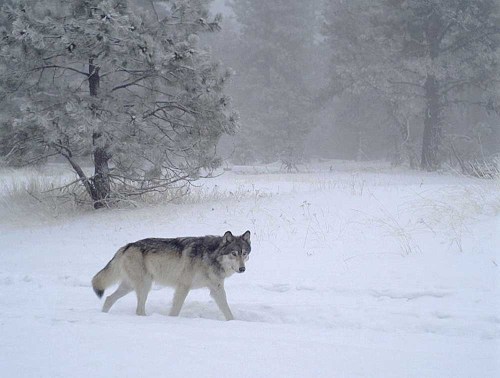ODFW approves killing more wolves from NE Oregon pack
Published 10:00 am Wednesday, June 22, 2022

- The breeding male of the new Chesnimnus Pack walks into camera view in December 2018 during the winter survey on U.S. Forest Service land in northern Wallowa County. Oregon Department of Fish and Wildlife officials on Friday, June 17, 2022, issued a second kill permit for Chesnimnus wolves.
JOSEPH — The Oregon Department of Fish and Wildlife has approved killing more wolves from the Chesnimnus Pack in Wallowa County to curb attacks on livestock.
ODFW issued its second kill permit for Chesnimnus wolves on Friday, June 17, after two yearling males were removed from the pack under a separate permit earlier this spring.
Trending
Since April 25, ODFW biologists have attributed five confirmed and two “probable” depredations of cattle to the pack in grazing pastures north of Joseph. The two most recent incidents were investigated June 4.
The agency issued its first permit April 29 to cull two wolves from the pack. One yearling male was shot May 3 and the second on June 10.
Days later, ODFW again authorized lethal take — this time for four Chesnimnus wolves, citing an ongoing threat to livestock in the area. The permit runs through July 17.
The decision has again inflamed emotions among both ranchers and wildlife advocates who disagree sharply about how wolves should be managed. Oregon has at least 175 wolves statewide, though that is a minimum estimate based on verified evidence.
Sristi Kamal, senior Northwest representative for Defenders of Wildlife, said that if the latest permit is fully executed, it will jeopardize the survival of the Chesnimnus Pack. The pack had at least nine members by the end of 2021, according to ODFW’s annual population survey.
“We are hoping that ODFW will not target helpless pups again but that means the permit will essentially wipe out most of the adult and yearling members,” Kamal said in a statement. “Depending on which two (or) three wolves are left, the survival chances of the pups decreases significantly.”
Trending
Kamal said the timing of the permit was also concerning, since there were no further documented depredations after the June 10 take of the second wolf from the pack.
“This permit feels unjustified,” she said.
Ranchers, meanwhile, have argued for killing the entire Chesnimnus Pack, claiming that nonlethal deterrents such as patrolling cattle and adjusting grazing schedules are not working to prevent losses.
John Williams, wolf committee co-chairman for the Oregon Cattlemen’s Association, said one heavily affected producer on Crow Creek has done everything humanly possible to keep wolves away from his herd.
“He’s still getting harassed, cattle chased and run through fences,” Williams said. “It’s ongoing and it’s continuing. The wolves that are there have decided to turn to livestock.”
ODFW agreed, stating that while the rancher has increased human presence to scare off wolves and removed potential attractants such as bone piles and carcasses, attacks on cattle have continued.
“Based upon all evidence available, ODFW believes that cattle continue to be at high risk of wolf depredation in this area,” the agency wrote.
Under Phase III of Oregon’s Wolf Conservation and Management Plan, ODFW can consider killing wolves to protect livestock east of highways 395, 78 and 95 after two confirmed depredations in nine months.
Wolves in the western two-thirds of Oregon remain a federally protected species.









